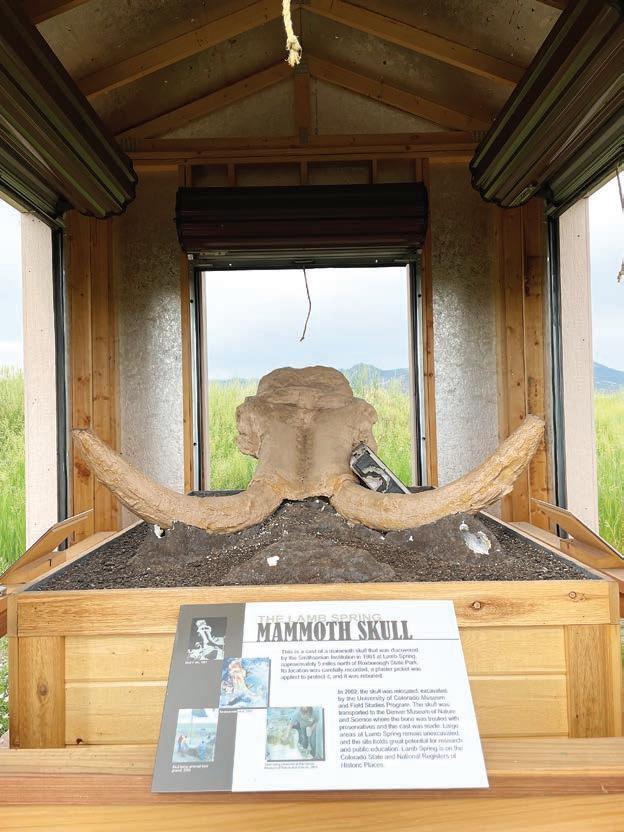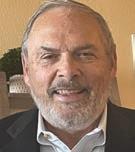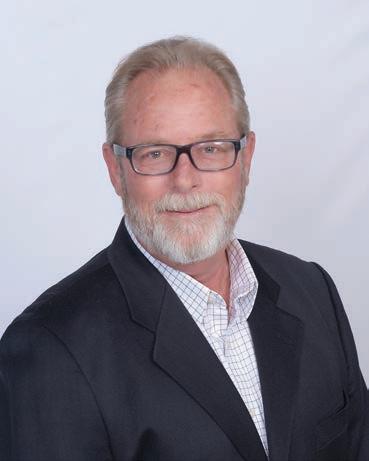
LONE TREE VOICE



LONE TREE VOICE

BY HALEY LENA HLENA@COLORADOCOMMUNITYMEDIA.COM
On the South Suburban Golf Course, Dylan Jimenez, a 12-yearold Highlands Ranch resident, stood in front of the tee of the Par 3 second hole on May 28.

Section included in this week’s edition P11
And with one swing of his golf club, the unimaginable happened that day.
PORTAL TO PAST
Lamb Spring takes visitors to the last Ice Age P2

Dylan Jimenez struck the ball and watched it y into the distance. e ball became smaller and smaller. In fact, he and his friends couldn’t exactly tell where the ball went.
At that moment, Joe Jimenez, Dylan’s father, got a call from his son as he was pulling into a parking spot at work.
Dylan said to his father: “I think I got a hole-in-one.”
Joe asked where the ball was and Dylan told his father that he thought it rolled towards the pin and that he was going to go look.


As they hung up the phone, Joe was overcome with excitement, and all he could think was: “I hope he got it.”

NEW HOCKEY RULES

Within minutes, Dylan Jimenez FaceTime called his father to show him that he got a hole-in-one. He told his father that people who had witnessed the ball go in were waiting for him at the hole, and once he got there, he was greeted with applause.
“Getting that FaceTime call from him was one of the best dad moments of my life,” said Joe. “Seeing and hearing the pure joy in his voice, and biggest smile ever, made me so proud.”
According to the National






SEE HOLE-IN-ONE, P4
Changes are made for high school athletics P4



ANIMAL ATTRACTION





Shop dogs make stores fun for owners, customers P16

Douglas County residents aren’t finished talking about how they want to be governed
BY JULIA KING SPECIAL TO COLORADO COMMUNITY MEDIA
Douglas County voters sent a decisive message with the June 24 home rule ballot: not so fast. But also — maybe not never?
ough home rule — the ability for the county to write
its own governing charter — wasn’t universally opposed, many residents objected to how the proposal was introduced. Roughly 71% of voters rejected the measure in the special election, but conversations about home rule and the structure of Douglas County’s government are likely to keep

unfolding. e election marked a moment of broad consensus in a county with a shifting political landscape. With una liated voters now making up about half of Douglas County’s electorate — which historically has been a Republican stronghold — the result o ered more than a simple party-line rebuke.
Nearly 95,000 ballots were counted on Election Night, with the vast majority — over 98% — cast by mail. Una liat-
ed voters made up the largest share of participants at 45.5%, followed by Republicans at 31.5% and Democrats at 23%. Turnout was highest among older voters, particularly those between the ages of 50 and 75, and was concentrated in larger suburbs like Highlands Ranch, Castle Rock and Parker. Voter trends were made more clear in district-level races for the commission that


Highlands Ranch Herald
A legal newspaper of general circulation in Highlands Ranch, Colorado, the Herald is published weekly on Thursday by Colorado Community Media, 115 Wilcox St., Suite 220, Castle Rock, CO 80104.
Send address change to: Highlands Ranch Herald, 750 W. Hampden Ave., Suite 225, Englewood, CO 80110
Call first: 115 Wilcox St., Suite 220, Castle Rock, CO 80104
Mailing Address: 750 W. Hampden Ave., Suite 225 Englewood, CO 80110
Phone: 303-566-4100
Web: HighlandsRanchHerald.net
To subscribe call 303-566-4100 or Scan this QR Code

STEVE T. STRICKBINE President steve@timeslocalmedia.com
NADINE JOHNSON
Director of Operations nadine@timeslocalmedia.com
NICK OLIVERI Director of Sales nick@timeslocalmedia.com
COURTNEY OLDHAM
Production and Design Director production@timelocalmedia.com
CHRISTY STEADMAN South Metro Editor csteadman@coloradocommunitymedia.com
HALEY LENA Community Editor hlena@coloradocommunitymedia.com
ERIN ADAMS Marketing Consultant eadams@coloradocommunitymedia.com






LINDSAY NICOLETTI Operations/ Circulation Manager lnicoletti@coloradocommunitymedia.com BY LILLIAN FUGLEI SPECIAL TO COLORADO COMMUNITY MEDIA
Columnists & Guest Commentaries
Columnist opinions are not necessarily those of the Herald.
We welcome letters to the editor. Please include your full name, address and the best number to reach you by telephone. Email letters to letters@coloradocommunitymedia.com
Deadline Tues. for the following week’s paper.

Colorado Community Media asks readers to make us aware of mistakes we may have made.
Email sgilbert@coloradocommunitymedia.com if you notice a possible error you would like us to take a look at.

Charles Lamb wanted to expand a natural spring on his land to create a stock pond for his animals. In 1960, when he started digging in northwestern Douglas County, his e orts were stalled by a discovery 13,000 years in the making: mammoth bones. Lamb knew the discovery was out of his league, so he quickly contacted the United States Geological Survey, who con rmed his discovery. Lamb had found the tusk of a Columbian mammoth.
Shortly after, archaeologists from the Smithsonian traveled to Lamb Spring to excavate the site, nding the remains of at least ve mammoths that came to the spring at the end of the last Ice Age.
Now, after excavations in the 1960s, 1980s and 2000s, Lamb Spring has quieted down. e site is empty most days, except for their monthly tours, or when Cameron Randolph — co-chairperson of the Lamb Spring Archaeological Preserve Board of Directors — goes out to mow in preparation of visitors.
Each month, typically on the rst Saturday of the month, LSAP o ers tours. At 9 a.m., Randolph and some volunteers lead visitors on a quarter-mile walk through the area, past a big depression in the land where the spring once was, to the site where the archeological exca-


At Lamb Spring, now in the Sterling Ranch area, excavations have occurred on a somewhat timely schedule. About each 20 years the land is dug up, unearthing new discoveries each time.
In the 1960s, along with the mammoth bones, archeologists found worked int chips — a sign of human activity in the late Ice Age. During this excavation, they also discovered that the site had two layers. One from the Ice Age, roughly 15,000 years ago, which is referred to as Unit 1, and one from roughly 10,000 years ago, lled with evidence of human hunting, which is referred to as Unit 2.
In the 1980s, excavation focused mainly on the older, Unit 1 layer. A full, juvenile mammoth skull was excavated, then reburied. In the newer, Unit 2 layer, more evidence of human hunting and bison bones were uncovered.
In the 2000s, the mammoth skull that had been reburied was once again uncovered.
e skull was taken to the Denver Museum of Nature & Science, where it was exhibited, stabilized and cast. e cast of the skull was brought back to Lamb Spring, while the skull itself is in storage with DMNS.
Bones from Lamb Spring are fragile — while they may seem old, compared to some archeological discoveries, they’re young.
“If you dig up a dinosaur bone, it’s going to be fossilized,” said Randolph, “ ese are not fossilized entirely. ey’re kind of in a state of fossilization. But they’re closer to bone.”
e mammoth remains’ fragility is where the cast comes in. Much sturdier, the cast is able to
live at the spring year-round, o ering visitors a glimpse into what lies beneath their feet. e layers at Lamb Spring have etched two histories into the site. One of the late Ice Age, with mammoths — and possibly humans — walking the land. Another 5,000 years later of humans surviving by hunting bison.
During LSAP’s tours, docents try to bring visitors back to those times, imagining what life would have been like in Colorado for the humans and animals found in the spring. Visitors even get hands-on experience by throwing an atlatl, an early throwing spear that would have been used for hunting.
Looking out from Lamb Spring, in the distance, Randolph can see Lockheed Martin. He says that on tour days, the building reminds him why the site still matters.
“Lockheed Martin is trying to de ne what the future looks like, and we’re actively trying to describe what the past looks like,” Randolph says. “I think it’s kind of important to talk about where we’ve been, while they’re talking about where we’re going.”
Randolph thinks that learning from the past can also help people prepare for the future.
“We try to stress the idea that you can learn from the past,” he says, “that there’s things we can be doing, and there’s things that we should be doing to protect nature. It shows how valuable some of those natural resources that we have are.”
More information on tours can be found at https://www.lambspring.org/free-tours/. Upcoming tour dates are July 5, Aug. 2, Sept. 6, Oct. 11. Tours start at 9 a.m. and typically conclude by noon.
This is the third installment of a monthly series about one of the hottest topics in real estate: Accessory Dwelling Units. ADUs have gotten a lot of attention recently as a housing option. You can read the previous installments online at my blog, http://realestatetoday.substack.com
My thanks to John Phillips of Verdant Living for helping with the research on this series of articles.
home improvement loan. It will probably be one of the largest loans the borrower has, exceeded only by the mortgage on their primary residence.
About ADUs
ADUs — detached accessory (or additional) dwelling units, also called mini homes — are a wonderful idea for the right homeowner. They use an existing piece of residential real estate and create a separate living space. They are often used for intergenerational housing (aging parents, 20-somethings just starting out, etc.) and have long term value as rental property and add to the value of your real estate.
whatever) or with help from parents/ children/friends.


In my Real Estate Today column on February 20, 2025, which you can read on my blog referenced above, I discussed the basics of ADU finance. Today, I want to talk a bit more about the dynamics involved.
Financial issues are an impediment to getting an ADU built because of two general issues.
Have a friend or relative co-sign for the loan (a solution that could involve sharing ownership of the real estate).
Consider ways to show the lender the value of the ADU. A rental agreement with the tenant who will occupy the ADU, explain the ongoing rental value, or show how the ADU will increase the value of the real estate (thus increase the value of the mortgage security). Note, this sort of thing is just now being taken into account by the mortgage industry.
ADU and leave the primary mortgage in place; the result would be a “blended” interest rate that may be more palatable. In addition, there is an emotional issue, which may be present in buyers of moderate means. Taking on substantially more long-term debt can be intimidating. The “need” has to overcome the understandable reluctance.
So, you want to put an ADU on your property. How do you pay for it?
A couple of basics. First, an ADU is part of an existing piece of real estate (a primary residence). As a result, assuming money is borrowed to pay for it, the loan will be within the mortgage finance industry. Until recently, very few in that industry were knowledgeable about ADUs, much less about how they could be financed. Banks, other lending institutions, mortgage brokers, government finance authorities, didn’t understand how they fit in, but that is changing. Second, the amount of the loan will be relatively significant, far more than purchasing a nice automobile, or a
Credit Qualification. As anyone who has purchased a home knows, the mortgage industry has an extensive process to determine the credit worthiness of a borrower for a particular transaction (income, debt-toincome ratio, credit score, etc.). This is one of the reasons the majority of ADUs are built by relatively well off homeowners. For those of moderate means, financing the construction can be a challenge. This is unfortunate, because those are the homeowners who might benefit most having an ADU for intergenerational housing and, in the long term, creating rental income and building wealth by enhancing the value of their most valuable asset, their home. If a homeowner has a real need, and is determined to build the ADU, here are some practical suggestions that might improve credit worthiness:
Lower the amount of the loan and thus the monthly payment by increasing the down payment, using available cash (savings or
I recently learned about a fascinating program called TACT — Teaching the Autistic Community Trades. I was so inspired visiting their Denver facility that I must share it with you!
TACT is a pioneering and innovative nonprofit organization that provides hands-on vocational and technical training to young adults with Autism Spectrum Disorder (ASD). TACT aims to combat the historically high 90% under- and unemployment rate within this community by equipping individuals with practical skills that lead to sustainable careers. Through its immersive training programs, TACT is preparing young people with ASD — who now represent 1 in 36 children — for high-demand careers in the skilled trades. TACT offers a wide range of programs, including auto mechanics, computer coding, cybersecurity, carpentry, electrical work, electric vehicle conversions, 3D modeling, welding, and culinary arts.
As a “specialized day school,” TACT also bridges the gap between secondary and postsecondary education, creating clear pathways to employment. Its programs empower students to become more independent and earn a living wage in high-skill, high-wage occupations. TACT remains the first and only trade program in the country designed specifically for individuals with ASD, and it has positively impacted thousands of individuals and families throughout Colorado.
TACT envisions a world where neurodiversity is not only accepted but celebrated, allowing individuals on the autism spectrum to fully contribute their talents and find personal fulfillment. With a mission to empower the entire spectrum of individuals with ASD through education and employment in the skilled trades, TACT continues to build on a strong foundation, fostering opportunities for success. I’ve posted an inspiring video at http://RealEstateToday.substack.com
In Colorado, legislation supporting ADU development (which takes affect this July) includes a provision (and some funding), tasking the Colorado Housing and Finance Authority (CFHA) with organizing a program that would help ADU purchasers of moderate means qualify for financing. That program should be announced soon.
Lower the cost of the ADU by choosing lower cost options, ranging from less expensive building materials to things like more affordable appliances.
Borrower reluctance. It should come as no surprise that interest rates play a major role. Homeowners can use the equity in their main residence (by refinancing their current mortgage) to build the ADU. However, if the primary mortgage carries a low interest rate, as most do these days, the borrower will not want to refinance at current rates.
A good alternative is to apply for a home equity line of credit (HELOC) to pay for the
Finally, there is the possibility of a third party (someone not living on the property) investing in the ADU, thus facilitating the financial piece. Under recent legislation the legal mechanisms to make it work would need to be developed. It is an interesting possibility and could overcome the financing obstacles, particularly for those of moderate means.
Although the dynamics are very different, a similar idea has been tried in South Africa to help ease the need for housing there. I have a link to a Bloomberg article about that project on my blog.
To help with these issues, Verdant Living has published a very useful buyers guide, BuyersGuideColoradoADUs.com, with advice on financing. Another good resource is the VerdantLiving.us, or contact John Phillips at 303-717-1962
I want to thank the following people in addition to John Phillips for their input: Jaxzann Riggs, The Mortgage Network; Kristen Stultz, Macro Financial; Charles Edington, LOANstar; Cindy Beier, Cindy’s Property Solutions.
Next month: Why smaller living spaces work well
Clickable links for each column can be found at www.JimSmithColumns.com
May 29, 2025 — Divorcing Couples With a Home Need a Realtor With Specialized Training
May 22, 2025 — Home Sharing Helps Single Seniors Deal With Finance and Loneliness, Allowing Them to Age in Place
April 24, 2025 — Lennar to Build 1,500 Geothermal Homes; My Review of the Mustang Mach E
April 17, 2025 — Redfin Report Highlights the Increasing Cost of Buying versus Renting a Home
April 10, 2025 — The Typical Wood-Frame, SiteBuilt Home So Common Since the ’90s May Soon Be a Thing of the Past
Mar. 27, 2025 — Here’s How Money Is Handled at a Real Estate Closing
Mar. 20, 2025 — Thinking of Using a Reverse Mortgage to Purchase a Home? Here’s Some Information
Mar. 13, 2025 — Will Colorado Be Able to Sustain Its ‘Green Agenda’ Under Pressure From Washington?
Pollutants Emitted When Cooking With Gas
Oct. 31, 2024 — Cooperative Living Presents an Attractive Alternative for Downsizing Seniors
Sept. 26, 2024 — Some Thoughts on Keeping Your Death From Becoming an Undue Burden on Your Heirs
Sept. 5, 2024 — What Knowledge and Skills Should You Expect Your Real Estate Agent to Have?
Aug. 8, 2024 — Seniors Over 70 Might Consider Downsizing Into a Rental, Not a Smaller Home
July 25, 2024 — Many Homeowners Don’t Understand Title Issues, Which Could Lead to Big Problems Later On
June 6, 2024 — Here Are Some Simple Steps to Take to Avoid Unpleasant Surprises After Closing
Mar. 21, 2024 — What’s Behind the Buzz About ‘Indoor Air Quality’ and ‘Sick Building Syndrome’?
Feb. 22, 2024 — Most Sellers Don’t Know How to Interview a Listing Agent. Here’s Some Guidance.


$1,195,000



Here’s why. The fully equipped 511-sq.-ft. heated workshop shown here is included in the 3,500-sq.-ft. custom-built home at 2069 Garrison St. in Lakewood. Every possible power and hand tool a carpenter might want is in this workshop. The rest of this 3-bedroom/3-bath house is amazing, too, starting with the great kitchen, which has a built-in Miele espresso machine (my favorite!) plus a Sub-Zero refrigerator with cherrywood doors to match the kitchen cabinetry. The seller-owned 17-kW solar photovoltaic system meets all the electrical needs of the home, including charging the seller’s electric car. See all these features and more in the 11-minute video tour I posted at www.GRElistings.com. The website contains more photos and full descriptions of each room. Sorry, there will be no open houses. Call your agent or me at 303-525-1851 to see it in person.
Mar. 6, 2025 — 62% of Americans Think a 20% Down Payment Is Required, But It’s the #1 Myth
Feb. 27, 2025 — As Society Deals With Homelessness and Affordability, Expect a Greater Focus on Manufactured Homes
Feb. 20, 2025 — We Have a Tool to Help You Find the ‘Perfect’ Home That’s Not on the MLS
Dec. 26, 2024 — As Pro-Tenant Laws Expand, Some Small Landlords Are Considering Cashing Out
Dec. 19, 2024 — What Are the Costs of Buying or Selling a Home in Colorado?
Nov. 7, 2024 — We Need to Take Seriously the

Dec. 21, 2023 — D.R. Horton Inks Deal to Build Homes With OSB Made From Grass Instead of Wood
Nov. 23, 2023 — Scamming Has Become Its Own Industry, and We’re All Prospective Victims
Sept. 28, 2023 — Insurance Companies Are Pulling Out of California. Is That in Our Future?
Aug. 10, 2023 — What Are Some Common Mistakes That Homeowners Make When Selling?
June 15, 2023 — Don’t Let Capital Gains Tax Deter You From Cashing Out on an Investment Property
May 11, 2023 — Do Agents Inflate the Cost of Buying or Selling Your Home with ‘Junk Fees’?






BY STEVE SMITH SPECIAL TO COLORADO COMMUNITY MEDIA
ree new rules will be in play when the 2025-2026 ice hockey season begins in Colorado.
e puck is unplayable if it comes to rest on top of the goal between the crossbar and the goal frame.
According to the National Federation of High Schools’ web page, the rule also clari es the rules for pucks on the outside of the goal netting and below the crossbar. Play continues in this instance.
“ e primary reason for stopping play when the puck is on top of the net is for the health and safety of players and the
goalkeeper,” said Dan Schuster, NFHS director of educational services and editor of the NFHS Ice Hockey Rules Book, in the statement on the NFHS web page.
“ e committee did not want to see sticks coming up high, trying to knock the puck o the shelf,” Schuster continued. “ e proximity of the goalkeeper is always sensitive, so there could be sticks coming in high in the direction of the goalkeeper and the committee did not want that in high-school ice hockey.”
Another rule will keep goalkeepers from wearing audio and video devices during games.
e last rule changes the word “linesman” to “linesperson.” e
federation’s rule book replaced gender-speci c language earlier.
According to the most recent NFHS athletic participation survey, more than 32,000 boys participate in ice hockey in 1,641 high schools across the country, and more than 9,600 girls participate in the sport in 785 schools.
Fifty schools eld boys teams that compete in seven conferences in Colorado, according to MaxPreps. Seven schools eld girls teams, according to MaxPreps. ose teams are in the southern end of the Denver metropolitan area, Castle Rock and one district team from Colorado Springs.
For more updates and rule changes, visit CHSAANow.com.


Hole-in-One Registry and the PGA of America, the odds of the average golfer getting a hole-in-one is about 12,000 to 1.
Todd Marley, head golf professional at the South Suburban Golf Course in Centennial, has been playing golf for 50 years and said hitting a hole-in-one is a very di cult feat because of the many variables involved.
“A large part of it is skill,” said Marley. “ e more often I can hit it close to the hole, the more chances I have. But there is an element of luck as well.”
Everything has to be perfect, Marley said — from the wind, temperature, how the ball hits on the green, how it rolls on the green, the speed of the ball, if it has the right curve.
“ e ball is 1.68 inches in diameter and the hole is four-anda-quarter inches,” said Marley. “ at’s pretty di cult to get that size into that size hole.”
Golf is a hobby that Dylan Jimenez picked up only about a year ago.
With his main focus on baseball, he had asked his father — who has been playing golf occasionally for a number of years — if he could join him on the course one day.
Now, Dylan is one of only ve golfers who shot a hole-inone this spring at one of the four South Suburban Parks and Recreation golf courses — one of which is an Arnold Palmer design.
Since it was a week before his 13th birthday when Dylan hit his hole-in-one, Joe asked his son if he wanted his own clubs for his birthday. But he said he would rather keep using his father’s clubs.
“It was like an early birthday present,” Joe said.






would have written the county’s home rule charter, had the measure passed. Candidates positioned against home rule consistently outpolled pro-charter voices. Voters didn’t just reject home rule — they chose leaders aligned with that sentiment, across both at-large and respective district candidates.
If the home rule measure had passed, none of the sitting commissioners — George Teal, Abe Laydon or Kevin Van Winkle — would have secured a seat on the charter commission based on the initial vote percentages, each nishing behind the top at-large candidates.
At its core, many voters said the outcome re ected a broader frustration with county leadership.
“ ere (is) a lot of simmering discontent with the commissioners,” said a lifelong Republican from Lone Tree.
For others, the rushed timeline and lack of public engagement were key.
“ ey didn’t give any education to anybody, and now they want us to vote on the largest change to Douglas County government in its history,” said Dawn Caldwell, a Highlands Ranch resident. “I think home rule can be good or bad … If they want to do it and do it the right way, with public input, I’m happy to do it with them.”
While Laydon said he acknowledges the voices of the voters, all three commissioners said in statements posted to the Douglas County website on June 25 that they are still supportive of a home rule charter.
“While this decision may be a reaction from one group on national issues, it also presents us with a vital opportunity locally to unite and move forward together to










create an even stronger Douglas County,” Laydon said in the statement.
Van Winkle added that he looks forward to continuing conversations about the importance of working together and local governance.
Teal interpreted the results as a call to slow down — not to stop.
“We were told several times during the course of the election campaign that … we’re moving too fast,” Teal told Colorado Community Media on June 25. “ e people of Douglas County told us this is too fast. We need a longer conversation.”
Teal also mentioned several possibilities that would keep home rule on the table, including writing a draft charter to share with the public, organizing town halls and collaborating with former home

rule opponents.
“I’m very tempted to reach out to several of them and have that conversation about … how could we do this to where you could feel comfortable to come on board,” he said. “ e conversation didn’t end yesterday. It really kind of just began.”
Some residents indicated they would be open to continuing the home rule discussion — under the right conditions.
“I think home rule could probably be a good thing, but our leadership chose to shove it down our throats,” said Angela omas, a Democrat who ran for the charter commission. “Local control is about the people, not about three commissioners deciding in a 92-second press conference that we’re going to have a special election that cost us $500,000,”


she said, referring to a special meeting in late March when the commissioners announced the home rule ballot.
Brad Geiger, a school board member who opposed the measure, said a future discussion would need to be more inclusive.
“I think there are things in Douglas County that could be improved,” Geiger said. “But to mislead people about what home rule can do, and to be so unclear about your goals … that will always o end voters, and it should.”
Geiger added he would only reconsider home rule under new commissioners. at sentiment — wanting change, but not under the current leadership — is also fueling a renewed push to expand the board of county commissioners from three members to ve. ough a home rule charter could have opened the door to that change, voters may now seek other avenues for it.
“I think ve just makes it more of a voice for people,” said precinct organizer Jenna Preston. “We are saying we’re ready for bipartisanship … based on the size of our county, it is mathematically called for.”
Teal, however, remains a vocal supporter of the current three-member structure. In April, he told Colorado Community Media that he would have liked to see a home rule charter cement that model into law. After the vote, he reiterated his position, citing e ciency and cost.
“You add more people to any organizational structure, you decrease e ciency of decision-making,” Teal said. He also estimated the cost of adding two commissioners would be about $500,000 annually.
Whether the county’s leadership will change its approach remains to be seen. Voters across parties sent a uni ed signal that the process must be more deliberate, inclusive and transparent.































































































Fifteen years ago, my father walked 1,000 miles in 1,000 hours. Despite worsening pain from blisters and muscle tears, he trekked day and night through Highlands Ranch parks to raise money for research on blinding diseases. And he did it all when he had lost the last parts of his own vision only a few months before.
While his ability to turn adversity into action continues to be a source of inspiration for me, something else impacted me just as profoundly: the support he received from the community. People from Highlands Ranch, Denver and beyond contributed their time to his journey and money to his fundraiser solely because they believed he was doing something worthwhile — that vision research mattered.
e idea that I could discover something new, that I could nd or develop something that would help people, has always burned at the center of my love of science and technology. at spark found direction in my rst biology course at Littleton High School; the incredible complexities of the natural world amazed me, and I
Letter to George Teal
Dear Commissioner Teal,


knew it was my path to develop or discover something that would help my father and those like him. is growing re eventually led me to pursue a Ph.D. at the University of Southern California where I studied changes in gene expression within developing photoreceptors — the light sensing cells in the eye. Unfortunately, for many people passionate about the sciences, chasing those dreams has recently become much harder.
e National Institutes of Health (NIH) and the National Science Foundation (NSF) are integral to all aspects of American research: from providing central and accessible databases to share work to funding research from scientists of all disciplines. Tax dollars spent through these agencies not only support critical research e orts but also pay back in spades; it’s estimated for every $1 spent by the NIH, $2.56 of economic activity is generated. In Colorado alone, it’s estimated that NIH

I am submitting this letter on behalf of members of the Asian community and the greater Colorado public to express our deep concern and outrage regarding your recent false and in ammatory remarks surrounding the outcome of Douglas County Ballot Question 1A. Ballot Question 1A was defeated in a free, fair, and democratic process, with 71.16% of Douglas County voters voting against the measure. To suggest, without evidence, that this outcome was the result of interference by the Chinese Communist Party is not only baseless but irresponsible. Let’s not parse words, it’s also just plain racist. We condemn these racially charged comments for it is provocative and dangerous.
e Asian American community of Colorado is outraged and troubled by your racially charged comments in which you falsely identi ed Dr. Eiko Browning, a Highlands Ranch resident and cancer physician, as “Chinese.” is statement is not only factually incorrect, but also insensitive, racially prejudiced, and completely unacceptable. Targeting an individual based on perceived ethnicity is discriminatory and undermines the values of respect, inclusion, and integrity that public servants are sworn to uphold. We call on you to:
1. Publicly retract your false claims about foreign interference in Ballot Question 1A.
2. Issue a formal apology to Dr. Browning and the broader Asian American community for your o ensive and racially charged statements.
As a long-time resident, parent, and emergency department nurse in Douglas County, I am deeply troubled by the absence of Pride Month displays in our public libraries this year. After visiting multiple branches, I found that no Pride materials were on display at all, not even subtly labeled ones. is is not only disappointing but harmful, especially in a county that claims to support diversity and inclusion.
In an e ort to understand this erasure, I reached out to library sta . I was told by one librarian, who asked to remain anonymous out of fear of retaliation, that internal guidelines shared this year emphasized avoiding displays on “alienating, challenging, or charged” topics, and that Pride-related materials were included in this category. Two weeks later, another internal email went out and the language was quietly removed, suggesting some discomfort or acknowledgment that such a stance was problematic.

3. Commit to conducting yourself with the respect and responsibility expected of an elected o cial in your position moving forward.
Douglas County deserves leaders who uphold truth, fairness, and unity — not divisiveness and misinformation. Your remarks have caused harm, and it is paramount upon you to take responsibility for these racially charged comments.
Angela omas, Castle Rock
support amounts to $567 million dollars which provides 6,971 jobs and stimulates $1.59 billion in economic activity.
e current administration has drastically undermined these critical engines of American research by rescinding or freezing previously awarded grants, purging expert personnel and slowing evaluations of research proposals or renewals. Limits are being placed on the portions of grant funds that help maintain university facilities and pay the sta that enable their laboratories to function. Federal grants are highly competitive but right now even having a grant reviewed is unlikely and researchers can’t count that what they have earned will be available to keep their laboratory going.
e loss of these funding sources has also massively harmed our next generation of scientists. Prospective graduate students, like I was not long ago, have had their acceptances revoked as some universities are now unable to nancially support pre-doctoral candidates. Without this federal funding, I may not have had the opportunity to train and study the visual system to help people like my father.

one. Why, then, is Pride Month treated any di erently?
Libraries are places of learning, diversity, and acceptance. If we are to uphold these values, we must ensure that Pride displays, and the visibility they provide, are not just included but celebrated in our community libraries. It is time for the Douglas County Library system to stand rm in its commitment to diversity and ensure that all people, regardless of sexual orientation or gender identity, feel seen, supported, and valued.
Adelita Campbell, Highlands Ranch Teal’s false allegations
As a Douglas County resident, I am appalled by Commissioner George Teal’s false allegations against a local political action committee. Teal claimed that the No Little Kings in Douglas County PAC was funded by a communist organization.
I realize that to many, science and scientists are distant ideas, and running a research group is a hard and often thankless task. However, government-funded research provides us with education, advancements in medicine and stimulates the economy. It helped a young boy from Highlands Ranch to become the rst in his family to graduate with a Ph.D. and chase a dream of healing blindness. Please take the time to remind your friends and neighbors of the amazing good that has come from American scienti c institutions. Contact your representatives about protecting scienti c freedom and funding. I believe our community supports curiosity, knowledge and learning, and that 15 years on, the walk still matters.
is guest column was written by Dominic Shayler, a postdoctoral fellow at the University of Colorado Anschutz who lives in Aurora with his wife and daughter. e opinions expressed in this column are the author’s and do not represent the position of the University of Colorado Anschutz Medical Campus.

Keep national politics out of schools
As I continue to watch Douglas County School Board meetings and listen to our elected school board members, I am increasingly surprised — and disheartened — by how frequently they focus on manufactured culture wars and attacks on the transgender community, which represents a very small portion of our student population.
I also spoke with a librarian who has served Douglas County Libraries for 14 years. She shared that this was the rst year guidelines regarding displays for monthly celebrations were instituted. is marks a signi cant shift in policy, one that appears to be a response to political pressure, rather than a commitment to the library’s core values of inclusion and representation.
Pride Month is a nationally recognized celebration of LGBTQ+ history, identity, and resilience. For LGBTQ+ youth, who face higher rates of bullying, discrimination, and mental health struggles, seeing their community represented in public spaces like libraries can be life-a rming. e absence of Pride displays sends a harmful message that LGBTQ+ individuals do not belong or are not valued.

We would never consider hiding or minimizing displays for Christmas, Black History Month, Women’s History Month, or other heritage months due to concerns that they might o end some-
When 9News asked for evidence that the PAC was funded by Chinese communists, as he alleged, Teal replied, “Is there evidence it isn’t?” e answer is yes. Yes, there is evidence.
Filings with the Colorado Secretary of State’s O ce show the PAC was funded entirely by Eiko Browning, a Highlands Ranch homeowner. e information proving who funded it is easily available to anyone who cares to look. Browning, an oncologist at Rocky Mountain Cancer Centers, itemized both her contributions and expenditures.
Commissioner Teal made this allegation in public and then doubled down on it. erefore, it’s only right that he set the record straight in public. His allegations are an implicit smear against a cancer doctor who took the initiative to participate in local politics.
For the future, I urge the commissioners to be more measured and accurate in their words. As a resident here for 17 years, I want elected o cials to look out for the interests of the entire county and not lob slander or lies toward any of my neighbors.

Jennifer Grothe, Sterling Ranch
As a longtime resident, parent, and teacher in the Douglas County School District, I am frustrated by the way national political agendas are being inserted into our local schools. I am far less concerned about the limited number of trans athletes in our district than I am about the real, pressing challenges we face: persistently low teacher salaries (despite the passage of the 2023 Mill Levy Override), rising incidents of bullying and harassment — particularly against our most vulnerable students — crumbling infrastructure, and an ongoing shortage of bus drivers that forces many students to nd alternative, and often unsafe, ways to get to school.
I urge the school board to stop dividing our community with partisan ideologies that do not re ect the values or needs of Douglas County. It’s time to focus on what truly matters: supporting our teachers, protecting all students, and ensuring our schools are safe, inclusive, and e ective learning environments for everyone.
Christina Marriott, Highlands Ranch
Teal’s ridiculous claim
I was stunned to read that Douglas County Commissioner George Teal blamed the Chinese Communist Party for the defeat of the home rule initiative. e measure was an attempted power grab and a bad idea. e commissioners held a rushed (and expensive) special election and promoted the measure using vague and unsubstantiated claims. A big part of pro-home rule donations came from real estate developers.
P9
Teal is not willing or able to take responsibility for this partisan asco that cost Douglas County taxpayers $500,000. Instead, he lashed out at an Asian American citizen by spinning an absurd and racist claim. Teal himself draws a salary of more than $150,000 according to the county’s website (douglas.co.us). As taxpayers, we should demand better governance and stewardship of our money from our commissioners.
I call on the other two commissioners, Kevin van Winkle and Abe Laydon, to take a clear position and distance themselves from Teal’s absurd claims.
Christine Remy, Highlands Ranch
JAA approval process was hinky
I support school choice and the establishment of charter schools, but I am deeply concerned about the approval process for John Adams Academy (JAA) in Sterling Ranch, Colorado. is is not an argument against charter schools in general, but against the lack of transparency, fairness, and accountability in how JAA was authorized.
On June 17, 2025, the Colorado Charter School Institute (CSI) approved JAA, despite widespread community opposition. e process began when Christy Williams, president of the Douglas County School District (DCSD), unilaterally placed a resolution on the agenda in November 2024 allowing JAA to bypass the district and apply directly to CSI. Sterling Ranch residents were given little notice, limiting their ability to respond.
Even DCSD board members raised concerns about the rushed and opaque process. e resolution passed by a narrow 4-3 vote. Among those voting in favor was Becky Myers, linked to Grandparents4Kids, a group led by JAA founder Linda White and known for opposing LGBTQ rights — indicating possible ideological motives behind the approval.
Several key JAA gures have ties to conservative political groups and local developers. Linda White and Ellen “Ellie” Reynolds, both JAA founders, are connected to Ready Colorado and to the Sterling Ranch developers who “generously” donated land for the school. ese overlapping political, nancial, and business relationships raise concerns about con icts of interest and whether the decision was truly made in the community’s best interest.
Sterling Ranch already voted to build a public neighborhood school, opening in 2027-2028. With nearby schools merging due to declining enrollment, JAA’s earlier opening risks draining public resources, especially since DCSD’s per-student funding averages $10,958.
JAA promotes a classical education model emphasizing Latin, cursive writing and Singapore math. While traditional academics have merit, I question its inclusivity and relevance for today’s society, neglecting global perspectives and STEM elds.
Further concerns include a 2024 lawsuit alleging California JAA’s falsi ed test scores. Despite claims of nonpartisanship, social media posts from Ellie Reynolds framed the school’s approval as a conservative victory. After the CSI vote, some of JAA’s founders mocked local opponents online, calling Sterling Ranch a “crazy neighborhood,” further damaging trust. is controversy is not just about one school — it’s about a broken approval system. e lack of transparency, potential con icts of interest, and disregard for community input reveal a troubling ero-
sion of public trust and democratic accountability.
Molly Whitehair, Sterling Ranch
Students deserve better
On June 17, the Colorado Charter School Institute (CSI) approved John Adams Academy (JAA) to open a new charter school in Sterling Ranch — but not through the oversight of the Douglas County School District (DCSD). at’s because the DCSD Board of Education chose to release JAA’s application to CSI, giving up local control and allowing a state agency to greenlight a school on Douglas County land, with Douglas County students, but without Douglas County accountability.
is was a stunning failure of governance.
JAA has a troubling academic track record in California. Its schools post chronically low test scores, high absentee rates, and subpar teacher credentialing. A former administrator has even led a lawsuit alleging falsi cation of test scores and religious discrimination. ese are serious allegations. Yet our board declined to conduct its own thorough review — even when residents raised these concerns repeatedly and in good faith.
Most alarming: JAA intends to build on a site previously understood to be reserved for a future DCSD neighborhood school. e community agged this issue early, but DCSD never even responded to CSI’s questions about the land. at’s not oversight — that’s negligence.
And now, DCSD will lose per-pupil funding for every child who enrolls at JAA. ose public dollars will follow students to a school that is not accountable to our elected board, our district sta , or our community. It’s a raw deal for taxpayers and a worse deal for families expecting excellence from their public schools. is did not have to happen. But four board members — Christy Williams, Becky Myers, Tim Moore, and Kaylee Winegar — voted to release JAA’s application to the state. at decision created this outcome.
Douglas County students deserve better. So do Douglas County voters. In November, we urge residents to hold these board members accountable and vote in leaders who will act with transparency, responsibility, and true commitment to our public schools.
Lori Wright, Sterling Ranch
It is apparent the Douglas County commissioners’ quest for more power and pushing the home rule ballot question went down big. I hope the commissioners are happy with themselves in spending our tax money foolishly for their personal agenda. I am proud in a Republican-dominated county voters didn’t fall in line with their leadership to pass this power grab item.
Since most home rule quests are usually citizen generated rather than from elected o cials, should the commissioners pay back the cost of this election through deducting it from their salaries rather than sticking it to taxpayers? ey wanted it so they should pay, not us.
Dave Usechek, Parker
Colorado Community Media welcomes letters to the editor. Please note the following rules:
• Email your letter to letters@coloradocommunitymedia.com. Do not send via postal mail. Put the words “letter to the editor” in the email subject line.


































Facility focuses on saving joint instead of replacement surgery
BY HALEY LENA HLENA@COLORADOCOMMUNITYMEDIA.COM
In the United States, corrective surgery for hip dysplasia typically involves two separate surgeries. But four Denver-based doctors have established a new surgical center that focuses on repair and preservation rather than replacement.
Based at HCA HealthONE Sky Ridge in Lone Tree, the International Center for Hip Preservation is the rst-of-itskind in the country to bring together internationally-recognized orthopedic hip preservation specialists to promote and advance the art and science of hip preservation.
“We’re doing our best to preserve the lifespan of (a patient’s) hips for as long as possible,” said founding member, Dr. Michael Ellman. “We are trying to perform procedures that are preventable, in addition to therapeutic.”
What is hip dysplasia?
Hip dysplasia is when the
top part of the femur does not t properly into the hip socket. According to the International Hip Dysplasia Institute, hip instability and dislocation are more likely to occur in infancy, and a shallow socket is more likely to be discovered during adolescence or adulthood.
While it’s estimated that about one- in-10 infants are born with hip instability and one-in-100 are treated for hip dysplasia, adult hip dysplasia is nine times more common than infantile hip dysplasia.
Hip dysplasia is also a leading cause of pain and instability in active women ages 13 to 40. It’s also a leading cause of early osteoarthritis in women under the age of 50.

BY HALEY LENA HLENA@COLORADOCOMMUNITYMEDIA.COM
Lighting reworks can be an exciting part of celebrating the Fourth of July, however, it comes with some serious hazards.
“It’s a fun time,” said Brain Willie, lead communications specialist with South Metro Fire Rescue. “But we also know that it’s very dangerous … with the hot weather we’ve had and everything is so dry.”
Willie said that the re district sees a large increase in calls in the days leading up to the holiday and on July 4.
Last year, South Metro Fire Rescue reported that the department responded to 45 res between 6 p.m. and midnight on July 4. e post on social media stated that most of the res involved grass or mulch, and most were caused by reworks.
Additionally, during that time, two people were injured in separate rework accidents, the re district reported.
Some reworks — such as sparklers, fountains and ground spinners — are permitted in Douglas County. ese can be purchased at local rework stands, which re marshals from the re district check to ensure that what is being sold is within regulation.


Since this demographic is at high-risk, Ellman said that early intervention is key to long-term mobility and a better quality of life.
e center also treats hip labral tears and impingements.
Hip labral tears occur when the
the hip tears and hip impingement — also known as FAI — is a condition in which irregularly-shaped bones in the hip joint rub against one another. Ellman said individuals are most likely born with the condition, rather than developing it over time, and can create

labral tears if not treated.
Treating hip pain
Rather than conducting a hip replacement, surgeons at the center work with patients to try to prevent them from get-
However, illegal reworks — which are reworks that leave the ground or explode — do get set o across Douglas County, according to the re district.
South Metro Fire Rescue is o ering some tips to properly dispose of reworks in order to avoid res or accidents.
e rst step is to let the rework sit for some time after it has gone out. Once it is cooled, it should be placed in a metal or steel bucket of water for at least 12 to 24 hours. is is to ensure that all the materials are fully saturated and there is no longer any exposure to ames, Willie said.
From there, put the soaked reworks in a trash container that is non-combustible. ese include metal or steel cans, which can be bought at home improvement stores.
“In Highlands Ranch, all our trash containers, pretty much, are all plastic,” said Willie. “So those are all very combustible and catch re.”
Willie said that many homeowners place their trash containers on the side of their house, either directly against their house or against a wood fence, which could lead to the house and/or fence catching re.
“We’ve had a couple incidents of
Andrew Bass was selected by the district’s board of directors June 24, following Rob Hanna’s resignation
BY ISABEL GUZMAN IGUZMAN@COLORADOCOMMUNITYMEDIA.COM
Andrew Bass has been selected to serve as South Suburban Parks and Recreation District’s new executive director, following Rob Hanna’s resignation in February.

Bass has worked as director of parks, recreation and community services in the City of Reno, Nevada, for seven years before joining the City of Chandler, Arizona, as its director of community services. He served in that role for nearly three years, then became Chandler’s deputy city manager
South Suburban extended the o er to Bass on June 24, and as of press time,
“My vision for the future of the district (is) one where we’re uni ed in purpose, and that includes all of our cities, counties and partners that we work with,” Bass said during his interview with the district’s board of directors on June 6. “(I want) our sta to be empowered to be in action — I don’t want sta coming to me for approval on every decision — I want to give vision, direction and guidelines to execute. e nal vision is to be deeply engaged. Hopefully, residents can feel like they can reach out to us.”
Bass emphasized the importance of the district’s workplace culture of encouraging open communication and trust among sta and directors.
“I want all team members to feel valued and connected,” he said.
Regarding South Suburban’s organizational chart, Bass said during his interview that he hopes to improve department structure by reducing redundant tasks, and enhancing communication by potentially implementing crossfunctional leadership teams. He explained these teams are composed of key department sta who meet regularly to address problems and provide updates.
During the June 24 board of directors’ special meeting, boardmembers shared that they enjoyed Bass’ positive approach to the role. “He was solid … Across all di erent (topics), he excelled,” said Elizabeth Watson.


that,” said Willie. “ at’s why we really want to just stress to put those reworks in water for an extended period of time.”
Parents and guardians should supervise children who have reworks, as the re district has seen a lot of children and teenagers light reworks in open space areas, causing vegetation and brush res.
For anyone lighting reworks, Willie said they should be in an area that is open with no combustible materials or dry grass, but to always check the county’s re restrictions rst. Douglas County’s re restrictions will be determined by the Douglas County


BY ELISABETH SLAY ESLAY@COLORADOCOMMUNITYMEDIA.COM
e Colorado Disability Funding Committee, operating under the Colorado Disability Opportunity O ce, will award $2 million in grant funding to 34 organizations across the state.
A spokesperson with the Colorado Disability Opportunity O ce said the grants will support new and innovative projects aimed at improving the independence and quality of life for Coloradans living with disabilities.
“ e funding for these grants comes from the partial sale of historical license plates, including the black-background license plates which have become very popular,” a spokesperson said. “ anks to the popularity of these plates, the Colorado Disability Funding Committee has been able to increase its grants over 300% in the past two years.”
Since the Colorado Disability Funding Committee was formed, it has funded disability application assistance grants to organizations that assist individuals and families with various applications for disability bene t programs. Recently, the committee divided the funding and allocated half of it to new ideas.
Sheri ’s O ce, and can be found on the agency’s website or social media.
e sheri ’s o ce will also have a hotline set up during the July 4 holiday for residents to report the use of illegal reworks. e hotline number is 303-8147118. e re district also advises residents to have re extinguishers handy and either a hose or a bucket of water nearby to quickly douse anything that might spark. In the case that something does spark, call 911.
While lighting reworks may be fun, the re district encourages people to instead attend an event where a professional reworks show will be presented.
“Just leave it to the professionals and go see a professional reworks display,” Willie said.
zations to receive funding for various programs such as education, employment advocacy and training, adaptive recreation, technology, housing, therapy and medical innovations, service animal training and placement, general advocacy and more.
A spokesperson from the Colorado Disability Funding Committee said the organization received 191 applications totaling over $15 million in requested funding.
“ e Colorado Disability Funding Committee is made up of 13 governor-appointed members, most members identifying as living with a disability or having rst-hand experience working with someone who does,” a spokesperson said. “ is committee worked tirelessly through 253 grant applications in order to select the recommended winners. e committee looked at how many people would be served, what geographical areas would be served and what new and innovative ideas would be employed to improve the lives of Coloradans.”
Applicants were eligible to request up to $100,000 each.
“ e organizations were delighted to hear they had been selected,
given the di cult budget year many of them are facing,” a spokesperson said.
Julie Deden, the executive director of the Colorado Center for the Blind in Littleton, said her organization is grateful for the $60,000 grant it will receive from the Colorado Disability Funding Committee in July.
“We’re planning on using the grant to assist blind people of all ages to work in the area of technology and to learn technology,” Deden said. “We’re going to be doing a lot more training in the area of technology, while at the same time weaving AI into it. So we’ll be working with people here at our Colorado Center for the Blind, but we’ll also be working with some blind people outside of the center itself. So we’re really excited about it.” e Colorado Disability Funding Committee said it was happy to see the high number of applications.
“While the demand for funding is high, we’re hopeful that as more Coloradans learn that the historical license plates aren’t just cool and trendy, they’re actually making a positive impact across the state, we’ll be able to increase the available funding even further in the future,” a spokesperson said.



ting to that point of needing a replacement.
Hip preservation surgery relieves hip pain by reshaping the natural joint or repairing damaged tissue. Ellman said that most people who receive a hip preservation operation undergo hip arthroscopy (PAO), which can involve reshaping the hip socket.
“ is isn’t like the standard 60-to-70year-old getting a hip replacement,” said Ellman. “ ese are anywhere from 12-to-45-year-old patients.”
Riley Gray, a 16-year-old athlete from the Centennial area, had the procedure.
She was an avid club volleyball player when the pain in her knees and back hindered her ability to move freely — and discovered she had hip dysplasia.
She underwent surgery at the beginning of the year and is now a volunteer at Sky Ridge. Not only does she help restock supplies, she has had the opportunity to speak with patients who get the procedure.
“It’s inspiring to see their faces light up when I tell them that I had it, too, and it’s all going to be OK,” Gray said. With more than a decade of experience, Ellman focuses on hip preservation and complex hip arthroscopy in young, active patients. He said that throughout his research, he has noticed that the metro area treats a high volume of hip preservation patients across from Colorado.
“(It’s) higher than most places in the country just because we’re attracting so many young, active people here who want to hike, (and) want to ski and
snowboard,”’ Ellman said.
e center in Lone Tree has performed approximately 1,000 surgeries since it opened in 2023, and having seen many gymnasts, dancers, runners and triathletes, Ellman hopes the center and the knowledge of hip preservation will become a new frontier in sports medicine.
“What we’re really doing is helping our patients continue to have a great quality of life and continue on being active and getting back to doing the things that they like to do,” said Wes Ayres, chief operating o cer at HCA HealthONE Sky Ridge.
Gaining an international perspective
With three pillars of focus: critical excellence, education and research, the goal of the center is to revolutionize surgical treatment, advance research to create best preservation practices and establish training programs.
It is using the latest technology — like an advanced CT scan that creates a 3D model of the patient’s hip — as well as collecting and tracking patient data to improve patient care and clinical outcomes.
In addition to working with specialists through HCA Healthcare, which is a 180-hospital system, the center is expanding beyond U.S. borders.
e center has about 40-to-50 surgeons from around the world, including the United Kingdom, South America, Switzerland and Canada, who join together via zoom to present di cult cases and work to nd treatment options.
“It’s been really bene cial to get an international perspective on a lot of hip patients,” said Ellman. “We’re really inviting anyone who can push the eld of hip preservation forward to join us.”
Medicare doesn’t pay for dental care.1
As good as Medicare is, it was never meant to cover everything. If you want protection, you need to purchase individual insurance.
Early detection can prevent small problems from becoming expensive ones.
The best way to avoid large dental bills is preventive care. Experts recommend checkups twice a year.
Previous dental work can wear out.
Your odds of having a dental problem only go up as you age.2
Treatment is expensive — especially the services people over 50 often need.
Unexpected bills, like $190 for a filling, or $1,213 for a crown3 can be a real burden, especially if you’re on a fixed income.
Simply


BY PAIGE GROSS NEWSLINE COLORADO
Environmental scientists and conservationists have been slow to embrace arti cial intelligence tools, in large part because of the enormous amount of electricity the technology demands.
But that, some say, is slowly changing as the potential bene ts of AI become clearer.
“I’m not a huge AI fan. If I can avoid it, I do, because I always think about the environmental implications rst,” Californiabased sustainability consultant Jennifer Brandon said. “But I am starting to see it around me and see the bene ts of it, especially with these huge data sets that we have.”
In one recent example, an Arizona State University climate tech project provides up-to-date water conservation information and suggestions for responsible water use over the last year via a simple, personable chatbot called “Blue.”


While Blue has given residents an easy, personalized resource to understand the state of water needs across the state, the environmental workers and researchers behind it carefully measure the overall impact of the project. Blue has been optimized to use less energy than similar tools, in a nod to the environmental mission of the project. Current arti cial intelligence systems require enormous power to drive data centers, and water to keep them cool.
“I think that it is not necessarily as clear to everyday Americans, about the connection between the development of AI and the physical infrastructure behind the technology and the subsequent energy, water and land use,” said Dave White, the director of the Global Institute of Sustainability and Innovation at ASU. Tech innovation over the last decade
Sales territories currently available in various communities.








has expanded the ways environmentalists can explore sustainability and conservation strategies, White said. But the decision to use newer tech tools, like AI models, which require physical infrastructure and large amounts of energy, water and other resources, isn’t a straightforward one for those interested in conservation. Concerns that AI’s spotty factual ac-
curacy could be a problem in the highly regulated world of environmental projects have also slowed the adoption of AI by those working in it.
For White and others, however, the potential gains made in the environmental sector need to be weighed against the negative environmental impact the technology creates.
“Sustainability is all about consideration of trade o s,” White said. “Can we get to net positive, where the energy consumption for the data centers that are backing AI is worth the value of gains that we’re potentially seeing on the conservation side? at’s where I would frankly say there’s not nearly enough critical evaluation and questioning of that issue.”
How is AI used in Environmental work?
Blue is one example of the tech-forward projects that the university is developing for more sustainability in the climate, energy, water and agriculture sectors. e
Julie Ann Wrigley Global Futures Laboratory launched the chatbot after receiving a $40 million investment from a statewide project within ASU, the Arizona Water Innovation Initiative, which brings industrial, municipal, agricultural, tribal and international partners together to try new strategies for water conservation.
White said that the best uses of AI that the University’s research projects have found have been in modeling, monitoring, management, prediction, simulation and scenario planning. An example of that is a recent study that used satellite observations, land surface models and data to track changes in total water stor-







age in the Colorado River basin.
“With new technology also, we’re able to link things like satellite-based observations with computer models that incorporate climate change and have that information inform our water resource management agency to help them be more e cient in the way that they manage the existing resources,” he said.
Outside of the university, White said he’s seen AI successfully help within the energy sector with demand management — modeling when equipment may break down or scheduling the optimal use of grid operations.
“I would say climate change, adaptation, mitigation is one area where we’re seeing promise,” White said. “In climate, we’re looking at opportunities where these AI-enabled tools, particularly those that are integrated with control systems and operating systems, can really help to optimize.”
Brandon said she’s seen some form of AI use in the sector for at least a decade. She remembers a classmate developing a machine learning algorithm to identify plankton during one of her Ph.D. lab courses.
“We could suddenly sort all of these images so much faster,” Brandon said. “And so there’s a lot of things like that. ey are trying to train AI on databases to see huge patterns of that data that would take us years and years to see those same patterns.”
Brandon also mentioned the growing practice of tracking carbon credits on blockchain, a distributed public ledger that isn’t AI based, but is often used in conjunction with AI technologies. Bran-
don said the carbon market hasn’t taken o previously because carbon credits weren’t easy to track, but blockchain provides transparency with a signature attached to each credit.
What’s holding environmentalists back?
Brandon described herself as more cautious about AI than some of her colleagues — “I’m an AI skeptic,” she said.
But she will be exploring AI on an upcoming research project to measure microplastics in minutes, as opposed to days, as is currently practiced. An AI algorithm will help her team identify what they’re seeing, instead of sorting them by hand and with lasers over several days.
Brandon said she’ll only consider AI where she sees a positive cost-bene t analysis or major time or energy savings. She’s also put o by inaccurate results given by AI, based on the data or information a model pulls from.
“ e accuracy is just not there yet,” she said.
It’s also a hindrance for Keith Lambert, president of Oxidizers Inc., an air quality systems company. While Lambert said he’s experimented with commercial AI products like OpenAI’s in his personal work, real-world engineering with AI presents a lot of risk.
Environmental work involves a lot of regulatory compliance, Lambert said, and any mistakes made by AI could cost a company or organization its ability to operate, or nes of tens of thousands of dollars a day.
“Clean data in, clean data out. And that’s the issue with AI right now, is where do you get true clean data?” Lambert said. “So you know that your actual metrics and the decisions, and the rami cations are in line.”
Lambert said he considers the environmental impact of AI, though every action




humans take has an impact. It’s about weighing the impact with the progress, he said, and for now, AI’s too risky to make a signi cant part of his business.
When AI is your sustainability business plan
For Amrita Bhasin and her business partner Gary Kwong, their homegrown AI model is the foundation of their logistics company, Sotira, that directs overstock consumer goods and excess food away from land lls to other sellers or food banks.
ey built their AI model to plan and optimize the logistics of getting excess food and commercial items across the country to places that can use or sell them for a discount. e model helps make connections between suppliers, buyers and charities, and predict the most e cient way to get goods where they need to go.
It’s a process that Bhasin, the company’s CEO, said would traditionally involve several phone calls, freight staging and coordination between trucks.
“Every single time you pack trucks more e ciently, you reduce the number of trucks on the road, and that makes a carbon emissions impact,” she said.
e pair won a grant from California organization StopWaste last year to ramp up its ability to get excess food to charities and nonpro ts in need, in line with new regulations in the state that say grocery stores must donate excess food instead of throwing it away.
Bhasin said she’s seen AI help with transparency within her industry and in helping with document-heavy compliance. It’s the “old school” industries like logistics and healthcare that could stand to see the biggest impact of AI, she said — “think about how much time it takes Americans to ll out insurance paperwork.”
“If AI were to automate all of that com-
pliance, like the [current procedural terminology] codes, that has a huge impact on society, I would argue, more so than like, making better Net ix recommendations or generating a better headshot,” she said.
Because they’ve built their own AI model, Sotira doesn’t rely much on generative arti cial intelligence, which has a bigger environmental impact than simpler machine learning models. ey also track the tokens — or amount of data processed with AI — each month to understand how much computing and energy they use. It’s a lot of mental math, she said.
“I do think that the only way to know that you’re doing good in this world is to know, like, we have rerouted 2 million pounds of overstock from land lls,” Bhasin said. “You can actually calculate it — ‘ is is how much carbon we have saved from the atmosphere, and this is how much AI I’m using, this is how much water and energy I estimate is from my AI.” ose in the climate and environmental space will likely continue doing that mental math more than other industries in deciding how or if to move forward with AI.
AI-cautious Brandon is hearing more projects or uses lately that she sees potential in, like AI helping make recycling easier, or AI platforms that provide real-time analysis of biodiversity data. But personally, she’ll continue to do a cost-bene t analysis before using AI.
“I feel like in my work, it has to have a huge bene t to outweigh the costs, because it’s just not worth it to me otherwise,” Brandon said. “And so when I see people using it to make their email sound better or to make their gures look a little nicer, yeah, I’m like, it’s not worth that.” is story is from Colorado Newsline. Used by permission. For more, and to support the news organization, visit coloradonewsline.com.
























BY ELISABETH SLAY ESLAY@COLORADOCOMMUNITYMEDIA.COM
In Denver’s bustling neighborhoods, it’s not uncommon to nd a shop cat curled up by the register or an excited dog greeting customers at the door.
Across the city, small businesses are embracing their four-legged companions, not just as pets, but as part of the store experience.
At Crystal Castle Beads, located at 2240 S. Broadway in Denver, two dogs — Ruby and Boss — have become as much a part of the shop’s identity as its crystals and handmade jewelry supplies.
Crystal Castle Beads
Owner Adrienne Lemke opened the shop with other co-workers in October 2023 after the previous bead store they worked at shut down.
“We just kind of came together and said, ‘Let’s start our own shop,’” she said.
Enter Ruby — a spirited pup with a nose for stones and a habit of napping on desks.
“I got her around the time we bought this building, on July 4,” Lemke said. “She’s been a part of this shop ever since. She helped us go through products, (she) tries to steal products … She knows the crystal business pretty well, and she has good taste in beads, too.”
Ruby quickly became the shop’s uno cial greeter, favorite distraction and emotional support creature all in one.
“People come for the dogs, not for us,” Lemke said. “Kids, husbands — everyone loves her. It really adds something special.”
But Ruby isn’t the only pup with a following at Crystal Castle Beads. General Manager Jennifer Niemela brought in her dog, Boss, under equally heartwarming circumstances.
After the loss of her previous dog, Niemela had no intention of adopting again. But life had other plans.
“Boss needed to be rescued, and I kind of needed a little extra happiness in my life,” she said. “So we in-




troduced him to Ruby to see if they got along. ey hit it o immediately.”
Now, Boss is a xture in the shop alongside Ruby.
“He’s happy, calm, super smart, and he loves sound healing,” Niemela said. “When I work with the bowls, he runs in like, ‘Yes, we’re doing sound healing.’ He just gets it.”
As customers wander through displays of stones and beads, it’s not unusual for them to be greeted by Ruby and Boss.
“People ask where they are before they ask about anything else,” Niemela said. “It’s kind of like they’re the real stars of the shop.”
While the pets might be the draw for some, they also reinforce something deeper — a sense of comfort and community.
“It’s soothing to have your dog at work with you,” Niemela said. “ ey make you smile. ey make everyone smile. at’s kind of what it’s all about.”









Jennifer
Owner of Sewn Denver Kirsten Coplans feels the same way about her dog, Kyoko, who can often be found lounging around the store located at 18 S.
Kyoko, who possesses a Japanese name that means “little girl,” is described by Coplans as smart, kind and
“ e question people ask me constantly is, ‘Is she always this chill?’” Coplans said. “ is is her second home. She’s used to everything — old people, young people, walkers, wheelchairs. She doesn’t get overly excited when people pet her. It’s just normal for her.”
Coplans adopted Kyoko from Low Riders of the West, a local small dog rescue, when she was just 8 weeks old. Kyoko isn’t the rst shop dog the business owner has
“My other dog, Pearl, was my shop dog for 13 years,” she said. “When she passed, I needed another dog in
Training Kyoko to be a shop dog started early. “I wanted to do a rescue, and I wanted to get a young puppy so I could start bringing her from day one,” Co-
Now 7 years old, Kyoko has grown into her role. “People lose their mind over a shop dog,” Coplans said. “It’s like they haven’t seen another dog anywhere else. ey might not say hi to me, but they’re de nitely gonna say hi to her.”
Kyoko has her own rhythm in the store and will move about the space seeking the best place to get comfortable — be it in front of a rack of vintage shoes or smack dap in the middle of the doorway.
“Sometimes she’s just like, ‘I’ve had too much attention today,’ and she’ll tuck herself away. But she also loves to see what’s going on outside,” Coplans said.
Coplans said Kyoko is very smart and always looking for food.
“She’s always checking people’s pockets or bags for treats. She’s de nitely an opportunist,” Coplans said. “ e UPS guy brings her treats. People bring her treats. She knows what she’s doing.”
Kyoko is a blue heeler, a breed known for being deeply loyal to their owner.
“She’s not really cuddly like a typical velcro dog,” Coplans explained. “But she always wants to know where I am. She just wants to have eyes on me.”
Sewn focuses on handmade and upcycled goods.
“We’ve got a handful of handmade artists, most of them local. One-of-a-kind items, eco-friendly, and we also carry vintage,” Coplans said. “My background is vintage fabric and patterns. I love connecting with people about what they’re making.”


1. TELEVISION: What is the name of the bar where Homer Simpson hangs out?
2. MUSIC: What are the rst names of the Jackson 5?
3. MOVIES: What prop is found in almost every scene in “ e Fight Club”?
4. ANATOMY: What does the term “hallux” refer to in human anatomy?
5. GEOMETRY: What is the perimeter of a circle called?
6. LITERATURE: What is Ron Weasley’s patronus in the “Harry Potter” book series?
7. ANIMAL KINGDOM: How many tusks does a warthog have?
8. GEOGRAPHY: How many states does the Paci c Crest Trail cross?
9. SCIENCE: What is a common name for iron oxide?
10. U.S. PRESIDENTS: Which president was awarded the Distinguished Flying



Cross for bravery in WWII?
Answers
1. Moe’s Tavern.
2. Jackie, Tito, Jermaine, Marlon and Michael.
3. A Starbucks co ee cup.
4. e big toe.
5. Circumference.
6. Jack Russell Terrier.
7. Four.
8. ree (California, Oregon, and Washington).
9. Rust.
10. George H.W. Bush. (c) 2025 King Features Synd., Inc.



Thu 7/10

Hand Turkey: Discovery Park Summer Concert Series



@ 5:30pm Discovery Park, 20115 Mainstreet, Parker
No Soap, Radio / Brittany Bridgewater & The Sparks / Sarah Adams at Roxy on Broadway @ 6pm Roxy on Broadway, 554 S Broadway, Denver
Bella Renee: DARKBLOOM: RYAN NEVIS
@ 6pm
Larimer Lounge, 2721 Larimer St, Denver
Julie Geller with David Ross and Ben Cohen
@ 6:30pm Kohelet, 428 S Forest St, Denver
88.5 KGNU Presents: The Meditations @ 8pm Ophelia's Electric Soapbox, Denver
Fri 7/11

Candlelight: A Tribute to Taylor Swift
@ 5:30pm / $26
Trinity United Methodist Church - Den‐ver, 1820 Broadway, Denver. fever@ eventvesta.com

B-Side: iies. & Lady Los
@ 6pm
Museum of Contemporary Art Denver, 1485 Del‐gany St, Denver
Phat Daddy
@ 7pm
Q's Pub and Grill, 10133 W Chat�eld Ave, Little‐ton Brunello
@ 9pm
The Basement at Club Vinyl, Denver

Gavin DeGraw with special guest Matt Schuster @ 7:30pm The Amphitheater at Philip S. Miller Park, Castle Rock
Sat 7/12

Littleton Artisan Fair
@ 9am / Free

Michael Kirkpatrick: Pickin' On the Dead
@ 3pm
5900 S Santa Fe Dr, 5900 South Santa Fe Drive, Littleton. events@colorado markets.com, 303-505-1856


Cockpit Demo Day @ 9am / $19.95
Air & Space Museum, 7711 East Acad‐emy Boulevard, Denver. info@wingsmu seum.org

Tantra Speed Date® - Denver! (Meet Singles Speed Dating)
@ 4:30pm / $50-$150 Samadhi Yoga, 639 E 19th Ave, Denver. help@ tantrany.com
COLORADO BLACK ARTS FESTIVAL
[Kid Astronaut + The Nebula FULL BAND SET]
@ 6pm
Colorado Black Arts Festival, City Park, Denver
Candlelight: Tribute to Fleetwood Mac @ 7:45pm / $26
Trinity United Methodist Church - Denver, 1820 Broadway, Denver. fever@eventvesta.com
Kaizen
@ 8pm
Larimer Lounge, 2721 Larimer St, Denver

Little Moses Jones Live At The Black Arts Festival @ 1pm
Colorado Black Arts Festival, City Park, Denver
AS WE RISE @ 3pm HQ, 60 S Broadway, Denver
Amalthea @ 4pm
Lost Lake Lounge, 3602 E Colfax Ave, Denver
7Horse (16 & Over) @ 7pm
Bluebird Theatre, Denver
Mon 7/14
Holy Wire @ 6:30pm Skylark Lounge, 140 S Broadway, Denver
Tue 7/15
Breckenridge Brewery, 2920 Brewery Ln, Littleton

Dirty Side Down Band: Dirty Side Down @ Sports Lounge Off Broadway @ 7pm
Sports Lounge Off Broadway, 44 W Centennial Blvd, Highlands Ranch

Sun 7/13

KB ANGEL: Sock Hop @ 10:30am
Charlie's Denver, 900 E Colfax Ave, Denver


Bonsai Workshop at Denver Beer Co. Lowry @ 5:30pm / $85

Denver Beer Co. Lowry, 7070 E Lowry Blvd, Denver. info@bonsaibar.com N8NOFACE @ 6pm Summit Music Hall, 1902 Blake St, Denver
Wed 7/16
Bonsai Workshop at Left Hand RiNo @ 5pm / $85 Left Hand RiNo, 4180 Wynkoop St #140, Den‐ver. info@bonsaibar.com
Liz Barnez: A Tribute to Joni Mitchell @ 5:30pm Four Mile Historic Park, 715 S Forest St, Denver
KenTheMan - Kinda Famous Tour @ 6pm Marquis, Denver
DJ Rockstar Aaron @ 7pm Bout Time Pub & Grub, 3580 S Platte River Dr A, Sheridan
Thu 7/17
Bailey Elora Trio at Civic Center Eats @ 10am Civic Center Park, Broadway and Colfax Ave., Denver
Blanke @ 5pm Red Rocks Amphitheatre, 18300 W Alameda Pkwy, Morrison
COPYCATT @ 8pm The Black Box, 314 E 13th Ave, Denver































































































































ONE AFFORDABLE MONTHLY PAYMENT PROGRAM
We work with you to set up a monthly payment that fits within your budget.

Do you owe more than $10,000 in credit card bills, medical bills or other unsecured debt? National Debt Relief can help! Our Certified Debt Advocates have helped over 500,000 people nationwide resolve their debt for a fraction of what they owe.
NO UPFRONT FEES
You won’t pay a penny until your debt is resolved.
RESOLVE YOUR DEBT IN 24–48 MONTHS We’ll resolve your debt as quickly as possible so you can finally start living the life you want.
I am so happy with National Debt Relief. They just resolved one account and saved me over $11,000. They keep me in the loop and work with me to get the most savings. —Cheryl (Trustpilot review)








